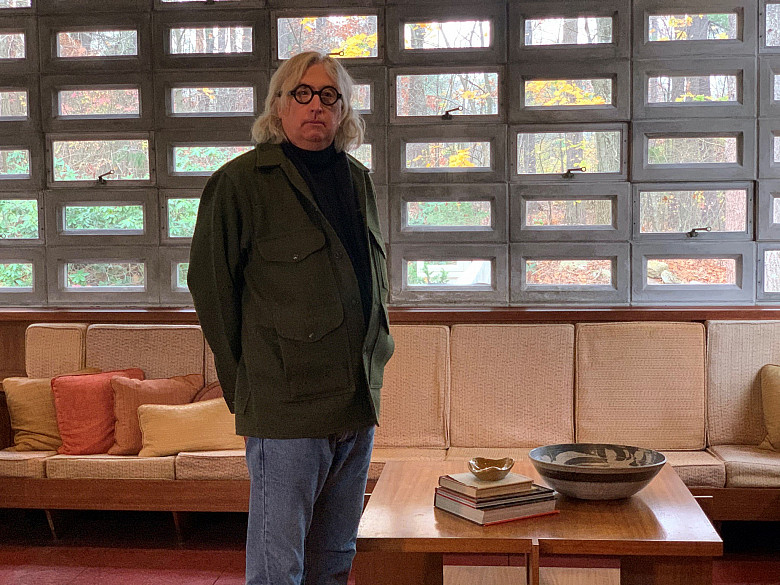It Was the Best: Learning to Read, Write, and Think Critically
As a senior curator at the Currier Museum of Art, Kurt J. Sundstrom’87 enjoys the luxury a small, well-funded museum affords him as an art historian and museum professional. Responsible for the museum’s collections, he organizes exhibitions on topics ranging from contemporary photography to Italian Renaissance sculpture, researches and publishes papers on objects in the museum’s permanent collection, and travels throughout Europe and the Americas in search of art acquisitions.
Among Kurt’s accomplishments are the identification of a Rossellino painted stucco relief in the museum’s collections, and a book on Frank Lloyd Wright’s Zimmerman House, which is owned by the Currier. A book on the museum’s second Wright acquisition,the Kalil House, is in the works.
Kurt credits his career trajectory to his Beloit College education.
“How did I land at Beloit? My parents knew that if I attended college in a bigger town or on a huge campus, I would succumb to the temptations of jazz clubs rather than go to class.”
Luckily for Kurt (and his parents), Beloit proved to be the perfect college and location to cultivate his curiosity and thirst for life. And at Beloit, he also gained the skills he would later need as a graduate student and a professional.
“I was that crazy, very liberal kid who questioned everything. Beloit College disciplined me and gave me the opportunity to find answers to my questions. I learned how to think critically, how to write, and how to express on paper complex ideas and thoughts concisely and clearly.”
Those skills developed because Beloit College threw challenges at him. Faculty expected him to “work his ass off” to learn what he did not already know and to debate ideas in class. And outside the classroom, there was plenty to discuss with other Beloit College students.
“I started out as a premed student and thought I’d major in biology. But then I took an American literature class with Tom McBride and an art history course with Debra Mancoff. Sometimes Debra had us spend an entire class dissecting a single painting. Debra taught us visual literacy: the language of art. She taught us how to look and listen to a painting and the skills of connoissership.
Tom McBride, in turn, taught his students how to read a novel or a short story, and to dissect a narrative. And like Kurt’s other professors, he expected students to come to class prepared. The Socratic method - dialogue between teacher and student - was the norm, and took. Indeed, it carried over into life outside class, when Kurt and fellow students would stay up late debating Kierkegaard’s philosophical ideas or discussing the latest Fellini or Kurosawa film while drinking beer. Studying with professors Mancoff and McBride taught students that literature and art are a shared experience; they spark ideas, as evidenced by those late night discussions.
Was attending class paramount? Of course! But then there was the time Pete Rose was to play in Chicago’s Wrigley Field, where he had a chance beat Ty Cobb’s record for career hits. A baseball fan, Kurt attended the game, and while Rose didn’t beat Cobb’s record, he tied it.
Back on campus, a call awaited. “Why weren’t you in class today?” Kurt: “I wanted to see Pete Rose try to beat Ty Cobb’s record.” “OK. I understand that. But don’t ever miss class again.”
Faculty members didn’t ask students why they hadn’t been in class because they wanted to punish them. Rather, they knew that students who didn’t attend class weren’t likely to be successful, and they wanted students to succeed.
Faculty also wanted to open students’ eyes outside of class. Thus, Debra Mancoff took students to the Art Institute of Chicago to view the art there; the visits led Kurt to intern there full time after he graduated from Beloit. Mancoff also ran a graduate-school-like seminar in Kurt’s senior year in order to prepare him and other art history students for graduate school.
Kurt had studied abroad in Florence for a semester, visiting every museum and church he could both there and in Rome, Venice, Milan, and other locations. Together with other students, he hitchhiked into the Italian countryside to visit the Villa Medici at Poggio a Caiano and traveled to Hungary to view its art and architecture. While some students on the Florence program treated the semester largely as an opportunity to party and shop, the Beloit College classroom experience had sparked in Kurt what is now a life-long interest in the creative arts from other countries.
The attention to exploring and learning paid off; when Kurt attended graduate school following the end of his Art Institute internship, he was as well prepared as any of the Ivy League graduates in his program. Unfortunately, some of the other students had not had the same rigorous training in critical thinking and writing, and left graduate school before completing their degrees.
His advice for Beloit College students?
“Seize every moment. Don’t waste opportunities. Over the four years you spend in college, you will have three or four experiences that will change the course of your life. You won’t know in advance whether it will be the lecture you attended by a visiting scholar, a politician you heard speak, or a film you watched. Beloit was the perfect place for me to develop socially, academically, and emotionally. It was the most comfortable place to learn. It can be that for you as well.”



